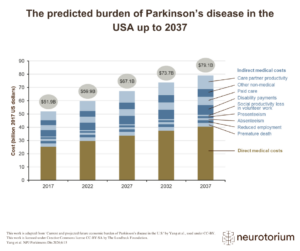Index for
slide deck
Title
-1024x576.jpg)
Course, Natural History and Prognosis
This presentation covers course, natural history and prognosis of Parkinson’s disease. The clinical effects of Parkinson’s disease (PD) are visually obvious, but the underlying pathology of PD is still not fully understood.
The course of Parkinson’s disease
-1024x576.jpg)
The course of Parkinson’s disease
-1024x576.jpg)
The journey of Parkinson’s disease
The clinical effects of Parkinson’s disease (PD) are visually obvious, but the underlying pathology of PD is still not fully understood.[McCann et al., 2016] PD pathology is thought to spread from brain region to brain region over multiple long-distance relays, during lon…
-1024x576.jpg)
Clinical symptoms and time course of Parkinson’s disease progression
The progression of PD is generally slow, taking place over years (often many years).[Kalia & Lang, 2015] While diagnosis tends to occur with the onset of motor symptoms, this can be preceded by a long prodromal phase of 15 years or more.[Goldman & Postuma, 2014] This prod…
-1024x576.jpg)
Thresholds for the appearance of Parkinson’s disease symptoms
Regions of the brain that are particularly vulnerable to Lewy pathology and degeneration during the earliest phase of PD include the olfactory bulb, a critical component of the sense of smell; the locus coeruleus, which produces noradrenaline and regulates sleep/wake cycl…
-1024x576.jpg)
The therapeutic benefits of modifying the disease course
While there have been major advances in the management and reduction of PD-related symptoms, there is still no effective way of preventing or slowing the underlying neurodegeneration.[Athauda & Foltynie, 2015; Ferreira et al., 2013] As the disease becomes more extensive d…
-1024x576.jpg)
Change in levodopa response over time – ‘wearing-off’
Levodopa is the major symptomatic therapy for PD and provides benefit to virtually all patients.[Obeso et al., 2000] During the so-called ‘honeymoon’ period, the effects of levodopa tend to be long-lasting and side effects are tolerable.[Obeso et al., 2000] Beyond this ‘h…
-1024x576.jpg)
Definitions of terms used in Parkinson’s disease
The slide includes some basic definitions of terms used to describe the course of PD.
References:
Hametner E, Seppi K, Poewe W. The clinical spectrum of levodopa-induced motor complications. J Neurol 2010; 257 (Suppl 2): S268–275.
Kalia LV, Lang AE. Parkinson’s disease. L…
-1024x576.jpg)
Drug-induced dyskinesias in Parkinson’s disease
Levodopa-induced dyskinesias cover a broad clinical spectrum of different types of involuntary movements, ranging from chorea affecting the limbs, trunk, and head, slow dystonic movements, fixed dystonic postures, or (more rarely) myoclonus or ballism.[Hametner et al., 20…
-1024x576.jpg)
Relationship between levodopa administration and motor fluctuations
As the extent of neurodegeneration in the substantia nigra becomes greater, its capacity to produce dopamine diminishes to the point where patients require larger doses of levodopa to maintain normal function.[Jenner, 2013]
Motor complications, such dyskinesia and motor f…
Prodromal Parkinson’s disease
-1024x576.jpg)
Prodromal Parkinson’s disease
-1024x576.jpg)
MDS research criteria for prodromal Parkinson’s disease
The Movement Disorder Society (MDS) research criteria for identification of prodromal PD were designed solely for research purposes since, for now at least, the lack of effective treatments that are able to halt the progression of prodromal PD makes their clinical use unw…
-1024x576.jpg)
Distribution of α-synuclein pathology in Parkinson’s disease
The Lewy pathology and aggregated α-synuclein proteins associated with PD are not confined to the central nervous system (CNS); they can also be found in the peripheral nervous system at various sites around the body, such as the skin, gastrointestinal tract, and salivary…
-1024x576.jpg)
The gastrointestinal system and Parkinson’s disease
!--?xml version="1.0" encoding="UTF-8" standalone="yes"?-- Neurons found in the enteric (gut) nervous system (ENS) require dopamine.[Rao & Gershon, 2016] Without dopamine, these neurons cannot properly control gastrointestinal motility.[Rao & Gershon, 2016] Animal studies…


-1024x576.jpg)
-1024x576.jpg)
-1024x576.jpg)
-1024x576.jpg)
-1024x576.jpg)
-1024x576.jpg)
-1024x576.jpg)
-1024x576.jpg)
-1024x576.jpg)
-1024x576.jpg)
-1024x576.jpg)
-1024x576.jpg)
-1024x576.jpg)
-1024x576.jpg)
-1024x576.jpg)
-1024x576.jpg)
-1024x576.jpg)
-1024x576.jpg)
-1024x576.jpg)
-1024x576.jpg)


